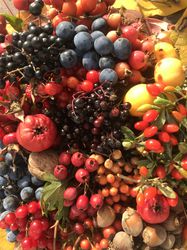 Learn more about Lubera Edibles’ range of wild fruit young plants.
Learn more about Lubera Edibles’ range of wild fruit young plants.
By definition, wild fruit is fruit that has been only minimally cultivated. However, since the transition to cultivated fruit is quite smooth, an exact separation is often not possible at all. Wild fruits are often pure processing fruits. But not all of them. There are also fruits that are very suitable for eating fresh.
In addition, the plants are not only valuable for harvesting. The wild fruit plants also have a high ecological value, be it in the spring as a source of food for bees or in the summer as bird food.
An overview of our current range of wild fruit young plants
In recent years we have been able to expand this niche assortment by introducing new products and we are now able to offer an entire range of species and varieties. We would like to introduce these to you below.
Common Elder – Sambucus nigra
Depending on the region, this plant is also known as black elderberry or elderflower. The elder is characterised by its robustness and undemanding nature. From the kitchen point of view, the elder is almost exclusively suitable for processing, both the flowers and the fruit. Depending on the variety, the ornamental value is very high.
Haidegg 17 – is a strong growing and high-yielding elderberry variety; this number selection is characterised by the very large flower umbels, on which also the high yield of this variety is based.
Black Beauty – is a red-leaved variety that has a very special ornamental value. In addition to the red foliage, the flowers have a striking pink colour at the beginning, which offers a very unique contrast to the blood red foliage. At the end of flowering, the blooms are almost pure white. The fruits and flowers of this variety can be used normally.

Picture: red-leaved elder 'Black Beauty'
Mulberries – Morus sp.
Mulberries bring a certain Mediterranean flair to the home garden. They are some of the few Mediterranean plants that also thrive north of the Alps. For the beginning, we have concentrated in our assortment above all on the not so strongly growing varieties. However, we are already working on expanding our range.
Mulberries are particularly suitable for eating fresh, as the soft fruits can hardly be stored. However, they can also be processed just as well into a wide variety of dishes.
Mulle – is a newer variety that was selected in Sweden. It is characterised by its very good frost resistance and a more compact and well-branched habit. The small, black and very sweet fruits ripen all summer long starting in July.
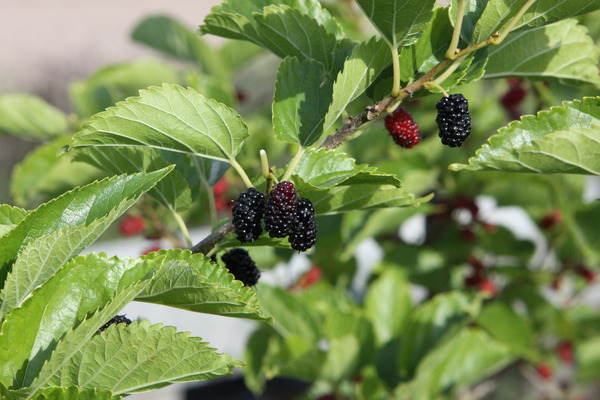
Picture: Morus 'Mulle'
Mojo Berry® – is also a relatively compact mulberry. This variety already bears lots of fruit at a young age and produces a variety of medium-sized, black and fruity-sweet fruits.
Goji – Lycium sp.
A few years ago this actually old acquaintance, at that time still known under the name 'boxthorn' and used as motorway greening, experienced a true new beginning – this time as a healthy vitamin bomb. But after the first hype came the disillusionment; often everything that could be found as plants was sold, no matter what was really behind it. From all this confusion we selected two promising varieties. Depending on the variety, goji are suitable for both eating fresh and processing.
Instant Success® – is a very fast fruiting variety that can produce its first yield in the year of planting. This variety grows only half as fast as other varieties. The taste of this vital berry, which is rich in active substances, is bitter-sweet with a bitter but also slightly pungent aftertaste of unripe tomatoes or peppers.
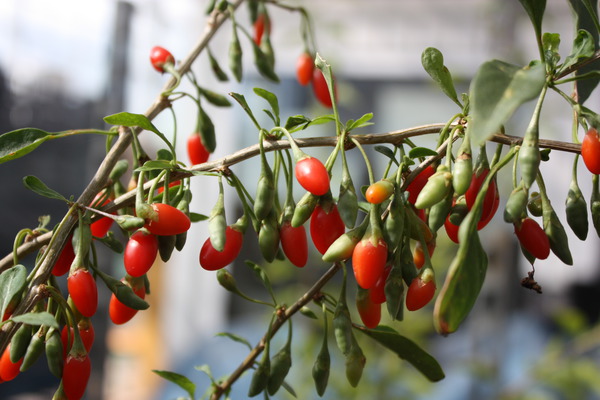
Picture: Goji 'Istant Success'
Sweet Success® – is a vigorous growing and rich fruiting variety. As the variety name suggests, this variety has a rather sweet, slightly bitter flavour. Therefore it is also suitable for eating fresh.
Chokecherry – Aronia melanocarpa
The chokecherry is a wild fruit from North America. It came to Eastern Europe at the beginning of the 20th century. This extremely robust and hardy shrub grows about 1.5 - 1.8 m high and 1 m wide.
Due to the very abundant white flowers with their red stamens, the chokecherries have a very special ornamental value, which is only surpassed by the fiery red autumn colouration. The small to medium-sized fruits are almost exclusively suitable for processing; only very hard-core people eat the fruits fresh.
Rubina(S) – has medium-sized, blackish violet fruits. The fruits have a bitter-sweet taste and are still slightly astringent when fully ripe. This is mainly due to the high content of active substances.
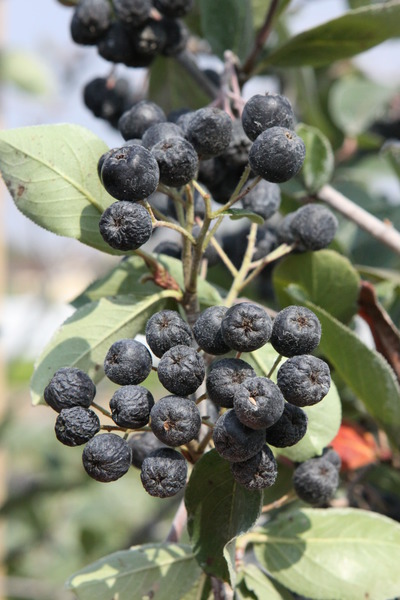
Picture: Aronia 'Rubina'
Viking – has in comparison the slightly smaller berries. This variety is moderately vigorous and forms shrubs with a final height of just under two metres.
Sea Buckthorn – Hippophae rhamnoides
Sea buckthorn is basically a very robust and undemanding plant; therefore it is also attributed to the pioneer plants. Sea buckthorn can cope with both dry and wet locations, but the soil should have a slightly higher pH value. In addition, sea buckthorn is a dioecious plant, meaning that both a female and a male plant are needed for a yield.
Tytti – is a very compact female variety which has been bred in Finland. Due to this origin, this variety has very good winter hardiness. The fruits ripen in the middle/end of August.
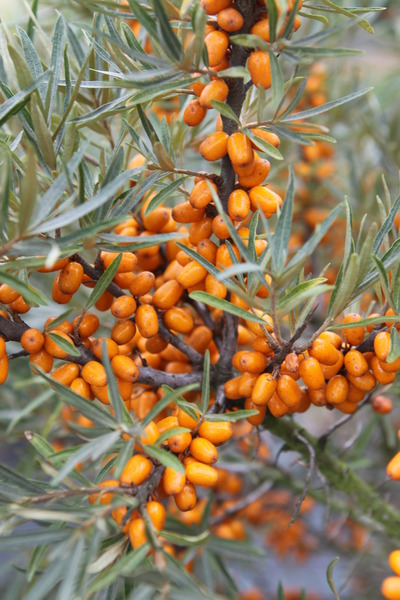
Picture: compact growing sea buckthorn 'Tytti'
Tarmo – was also bred in Finland and is the male pollinator variety for 'Tytti'. However, this variety is also suitable as a pollinator for other female varieties.
Damson – Prunus domestica subsp. insititia
The damson is a wild plum speciality from the Franconian catchment area, but this plant species is also known in other parts of Germany and Europe. In Franconia, the damson is mainly used for producing distillates. However, it is also well suited for eating fresh.
The blue and ripe fruits have a plum-like shape, but do not have their size, and they ripen around the beginning of August. The plants grow into a large shrub or a small tree.
Bullace – Prunus domestica subsp. insititia
Like the damson plum described above, the bullace is a wild plum speciality that forms a well-branched, large shrub which only sporadically forms spines. The spherical-round, dark blue fruits are generally larger than those of the common sloe, but much smaller than those of the damson. Bullace fruits ripen around mid-August and taste sometimes sweeter and sometimes rather bitter-sour, depending on the direct sunlight.
Where is the range of wild fruit young plants heading? Here is a brief look into the near future
In order for you to remain competitive with your range, we are always working on expanding our range or, where the necessary potential exists, replacing it. Every year we test new wild fruit varieties and selections regarding their suitability for the home garden. We would like to introduce you to the most interesting of these.
Please note that these novelties are currently still in the test phase and no young plants are available at this time.
Sea Buckthorn (Hippophae rhamnoides)
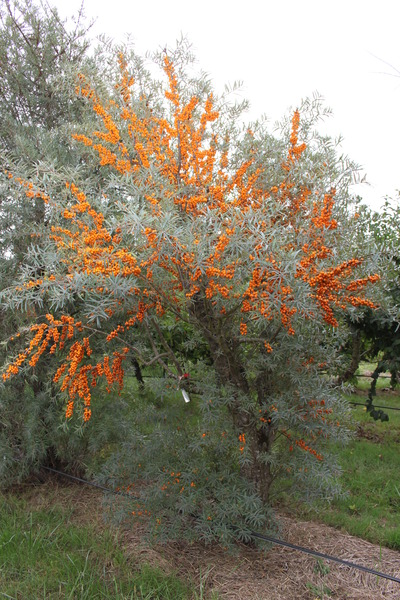
Picture: ripe fruits on a sea buckthorn shrub
In the first section we have informed you about our current sea buckthorn assortment, but this is not all. We are currently working on the introduction of new varieties. These are mainly normal-growing varieties, some of which will be thornless or even suitable for eating fresh, of course also with a suitable pollinator variety.
Compact sour cherries (Pr. fruticosa x Pr. cerasus)
Compact sour cherries are a very exciting new type of fruit. Unlike the normal sour cherries, compact sour cherries can be grown and kept very well as a shrub. This could only be achieved by cross-breeding the compact Prunus fruitcosa. This results in a completely new approach in the home garden, namely growing fruit species as shrubs that actually grow like trees.
Mulberries (Morus sp.)
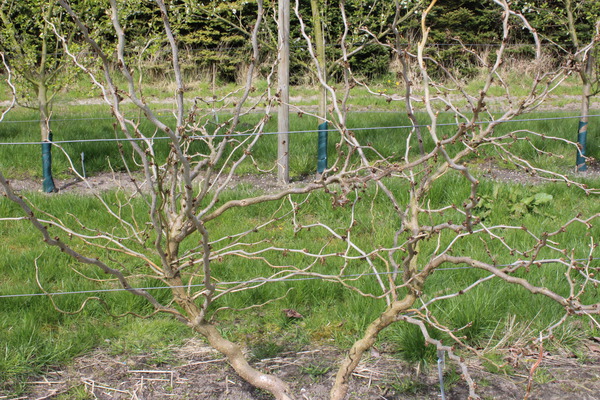
Picture: Mulberry 'Zickzack'
In the case of mulberries, we initially concentrated on introducing weaker varieties. Now we are also concentrating on the establishment of mulberry varieties that have a strong tree-like habit. Examples are the variety 'Illinois Everbearing' with its large and aromatic, sweet fruits or the variety 'Zickzack' with its interesting zigzag growth.
Saskatoon (Amelanchier sp.)
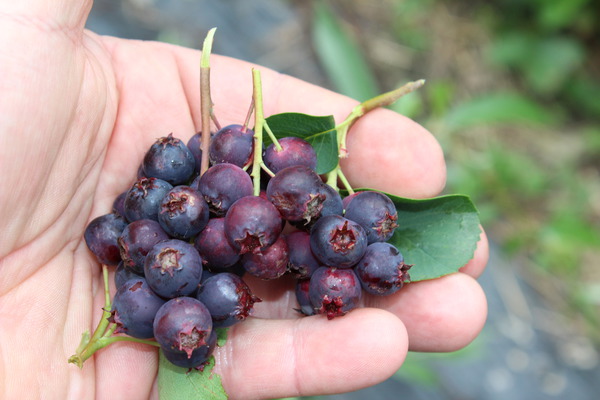
Picture: Saskatoon selection with large fruits
The Saskatoon is a very interesting shrub, especially for the home garden, as it has an obvious value as a fruit plant as well as a very high ornamental value throughout the year. In the spring, it has numerous flowers, followed by copper-coloured shoots. In the summer, the sweet and tasty, dark blue berries develop. And in autumn the serviceberry surprises with an unusually intense autumn colour.
